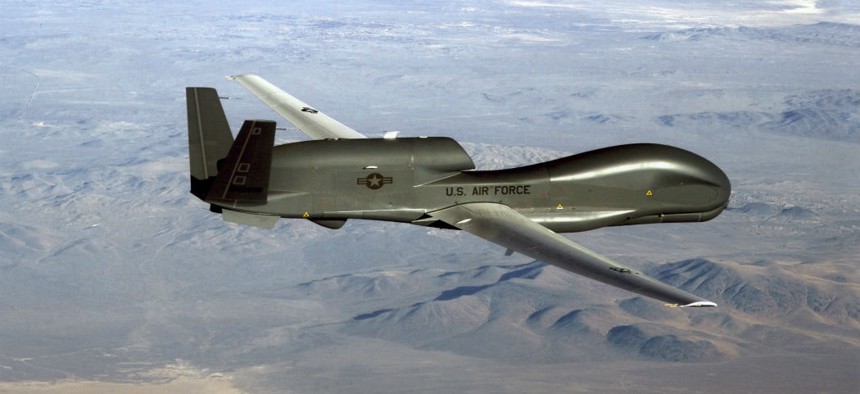ISR payload demo begins on Global Hawk
Northrop Grumman begins flight tests of the MR-177 imaging sensor on the endurance UAV.
Flight tests have commenced on a new sensor payload the Air Force plans to deploy on Global Hawk autonomous aircraft as they replace aging U-2 spy planes.
Northrop Grumman Corp. said this week it completed the first in a series of planned flight tests of the MS-177 multi-spectral imaging sensor aboard an RQ-4 Global Hawk. The long-range sensor is built by UTC Aerospace Systems, a unit of United Technologies Corp.
Prior to the Global Hawk tests, the sensor suite was demonstrated in flight tests last year conducted by UTC. Following those trials, the Air Force awarded UTC a design contract to expand the sensor's multi-spectral resolution capabilities.
The MS-177 payload is the next generation of the company's current sensor, the Senior Year Electro-optical Reconnaissance System-2 (SYERS-2) currently flown on U-2S spy planes. UTC claims the new sensor payload can provide the longest range imaging capability in the U.S. military's surveillance and reconnaissance arsenal.
Along with spotting targets at long range using a wide area search capability that relies on multiple sensor technologies, the payload is billed as being able to track and assess targets via "multiple sensor modalities," Northrop Grumman said.
Deployed on Global Hawk, which can remain aloft for more than 30 hours, the high-altitude platform is expected to gather near real-time, high-resolution imagery over wide areas day or night. The MR-177 platform was previously flight tested aboard an Avenger (formerly Predator C) drone built by General Atomics as well as an Air Force E-8C Joint Surveillance Target Attack Radar System. However, the operational version will fly only on the Global Hawk.
The sensor payload was shipped to Northrop Grumman's facility in Palmdale, Calif., for laboratory tests at the end of last year.
Previous flight tests aboard the Global Hawk included the SYERS-2 platform and the U-2 Optical Bar Camera. The high-altitude and satellite reconnaissance camera also built by UTC is used to capture high-resolution, panoramic images.
According to reports, initial testing of the MR-177 payload by Northrop Grumman includes gauging airframe characteristics based on payload weight. Program managers also have said they will demonstrate the ability to record and transmit ISR data. The company also said it expects to advance from the current seven-band multi-spectral system to a suite that operates in as many as 10 spectral bands.
Flight tests of the MR-177 payloads aboard the Global Hawk are scheduled to continue through the middle of 2017. The ISR platform could be fielded as early as the end of the year, UTC said last fall.





